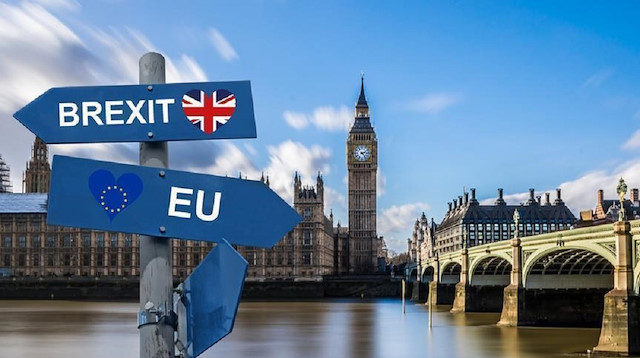
British Prime Minister Theresa May is seeking much needed approval from the House of Commons for her European Union withdrawal agreement in a historical vote to be held Tuesday evening.
The deal was originally scheduled for a parliament vote in December, but due to strong opposition, May postponed it to Jan. 15.
She has not garnered sufficient support for the deal, however, and not only the opposition parties but also backbenchers from her own Conservative Party have declared they would vote it down.
On Monday, she asked MPs to “give this deal a second look” before the key vote.
In a statement Monday evening to the House of Commons, May argued that if the deal is agreed, the UK and the EU will have almost two years to negotiate the final trade deal, which didn’t make much of an impact on MPs.
May welcomed new EU assurances over the impact of the deal on Northern Ireland, saying they had "legal force".
European Council President Donald Tusk and European Commission President Jean-Claude Juncker stressed in a letter that they will try to find technical solutions to the Irish border issue that would make the backstop redundant. But the letter had little effect as MPs argued that they were not legally binding documents.
May needs the support of 320 MPs to have her deal voted through the House of Commons.
The total number of seats in the House is 650.
There are only 639 eligible votes, however, as Speaker John Bercow and his three deputies as well as seven Sinn Fein MPs will not cast ballots.
So the deal effectively needs the votes of at least 320 members.
The vote will be held in the House of Commons at 7 p.m. local time.
Conservative Party
The leading party has 316 votes in the House, but not all of them are expected to vote in favor of the deal.
May suffered two humiliating defeats last week after some ruling Conservative and main opposition Labour MPs voted to strengthen parliament’s hand in heading off a no-deal Brexit.
Some of the hardline Brexiteers, including former Foreign Secretary Boris Johnson, former Brexit Secretary David Davis and staunch Remainer MP Anna Soubry, openly said they would reject the deal.
Around 20 MPs voted against the Tory whip in two key votes last week.
Labour Party
Led by Jeremy Corbyn, the Labour Party currently holds 257 seats in the House of Commons. Corbyn has repeatedly said they would vote against May’s deal.
On Monday, he said May has failed to get the legal assurances she promised and the House would vote on exactly the same “botched” deal.
He said the government is in disarray, and if the deal is rejected, it is time for a “general election and a new government”.
Scottish National Party
The Scottish National Party (SNP) said the deal was not in the best interests of the Scottish people and businesses and so they will not back the deal. The SNP has 35 MPs.
Liberal Democrats
The pro-EU party made clear there would be a party whip to vote against the deal. It holds 11 seats.
Democratic Unionist Party
The Democratic Unionist Party (DUP), the government’s de facto partners since May lost a parliament majority in 2017 snap elections, also said they would vote against the deal, as they are unhappy about its backstop article.
The DUP votes are crucial even if all Tory MPs vote in favor of the deal, as May will need at least four of the Northern Ireland party’s votes.
As the UK will leave the bloc in March 2019, the border between Northern Ireland – a UK territory – and the Republic of Ireland will remain as the only land border between the UK and the EU.
The border at the moment is invisible, and people, goods and services can travel through it freely. But as the UK leaves the EU, the border, technically, will need some sort of checks.
Due to the sensitive nature of the region and because free passage is one of the crucial articles of the 1998 Belfast Agreement, the UK, EU, Northern Ireland and Ireland all reject the idea of returning to a hard border where checkpoints and customs buildings will need to be installed.
The border issue has been one of the thorniest in Brexit talks, as a solution that would be acceptable for all sides is still to be reached.
The main disagreement over the border issue has been over a EU-suggested backstop – keeping Northern Ireland in the EU single market and customs union after Brexit until a solution is found – because it would create a sort of a border within the UK in the Irish Sea.
May has continuously said they would not give in to any solution that would divide the UK.
The DUP, which is also Northern Ireland’s biggest political party, has said it would not agree on any final deal that would separate Northern Ireland from the rest of the UK.
Therefore, May negotiated a backstop for the whole of the UK and the deal included this after agreement was reached with the EU. However, the Brexiteers are not happy with this clause as the parties cannot end the backstop unilaterally according to the deal.
The prime minister is expected to brief parliament on the government’s Plan B in three working days.
May has argued that her deal is the best for the country’s interests and the alternative would be leaving the union without a deal.
Scenarios should May suffer a defeat today include her resignation, renewed general elections, an extension to the Article 50 process, a public referendum on the deal or a no-deal Brexit.
The UK is set to leave the bloc on March 29 after more than 40 years of membership.

























